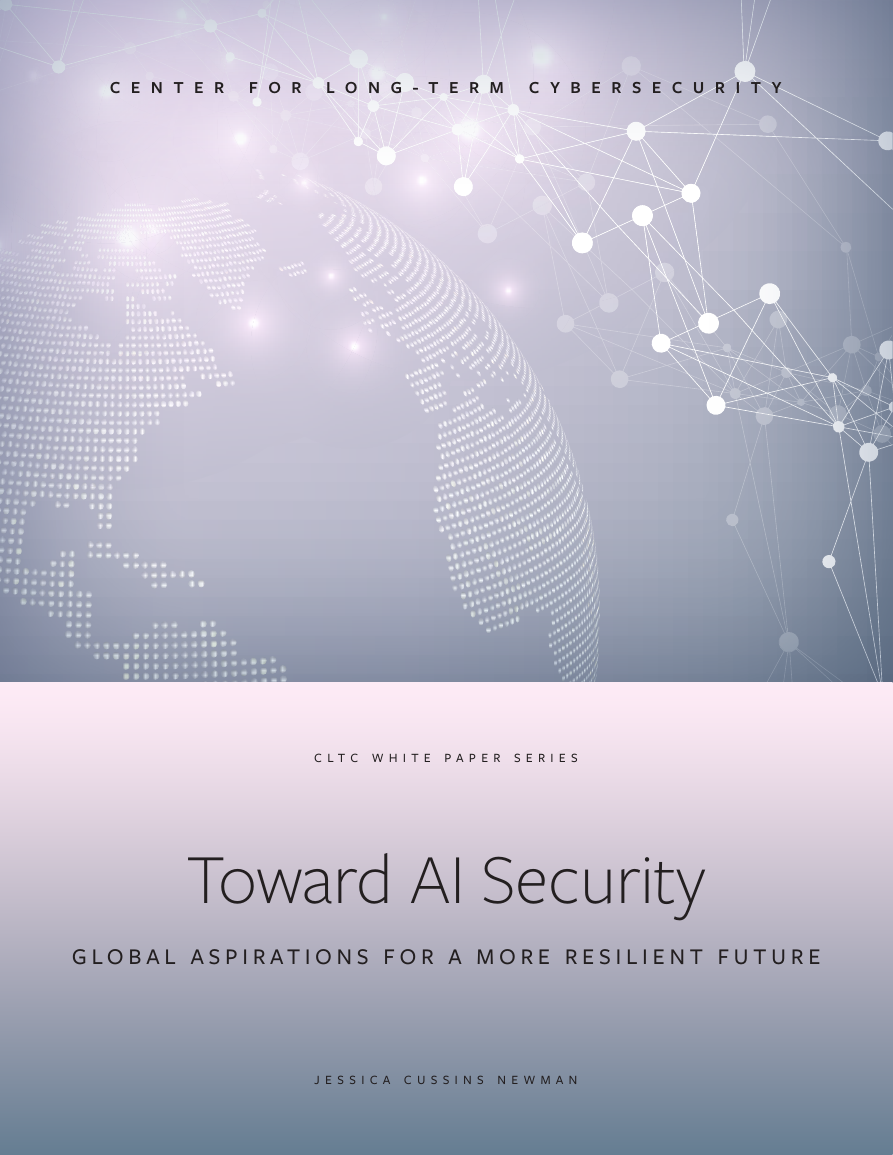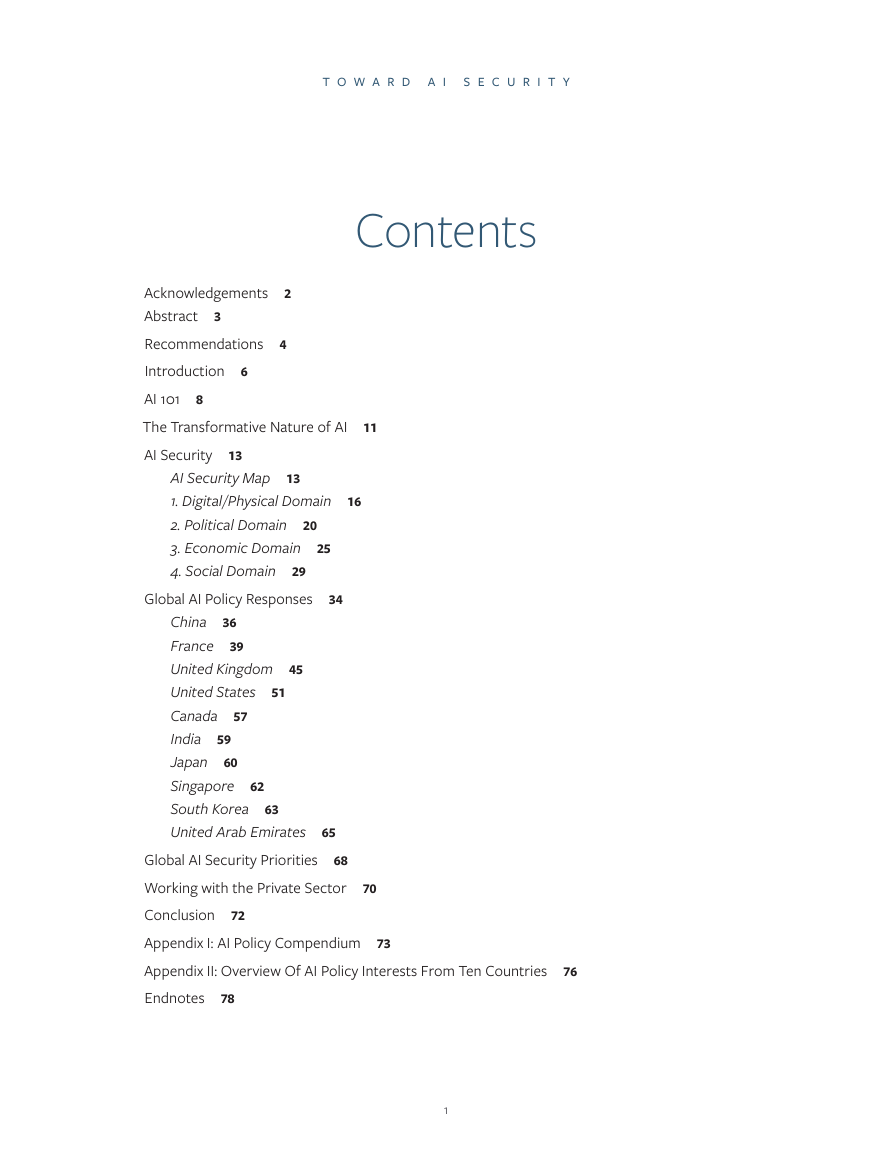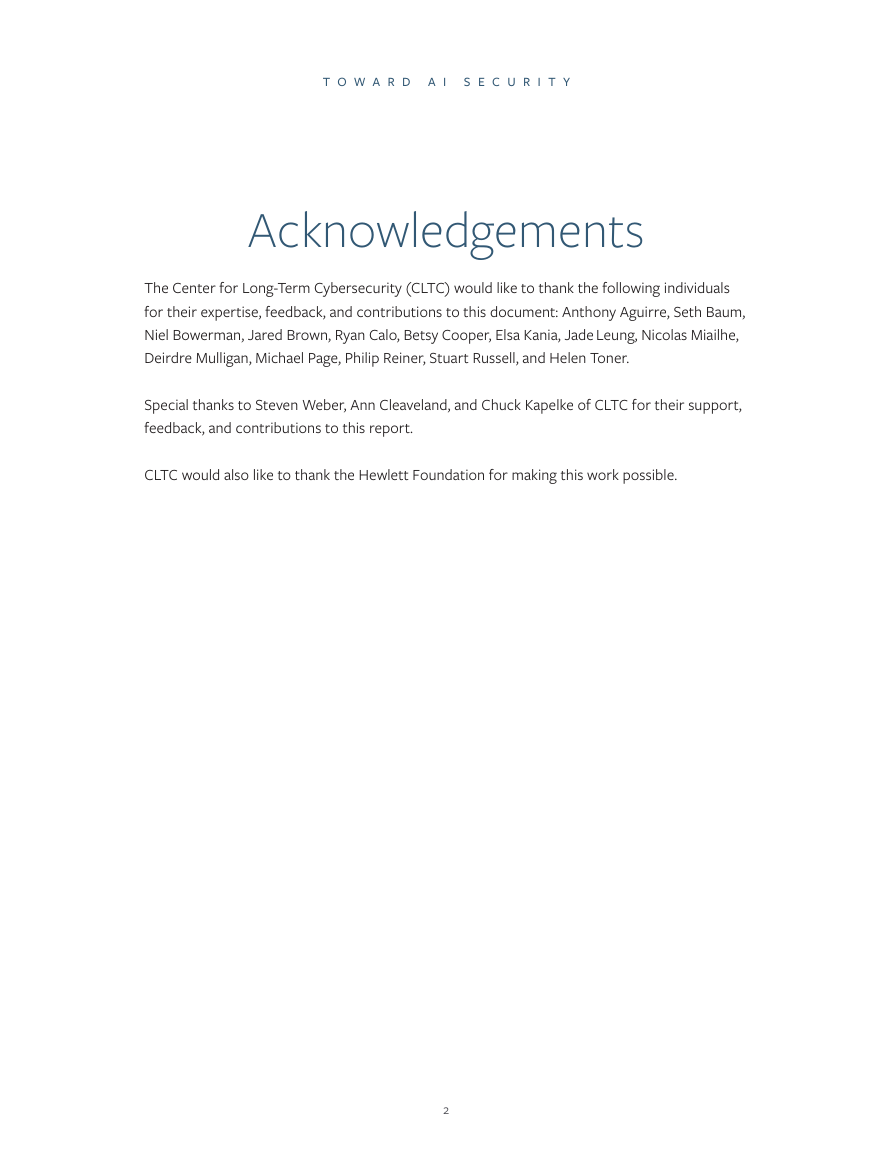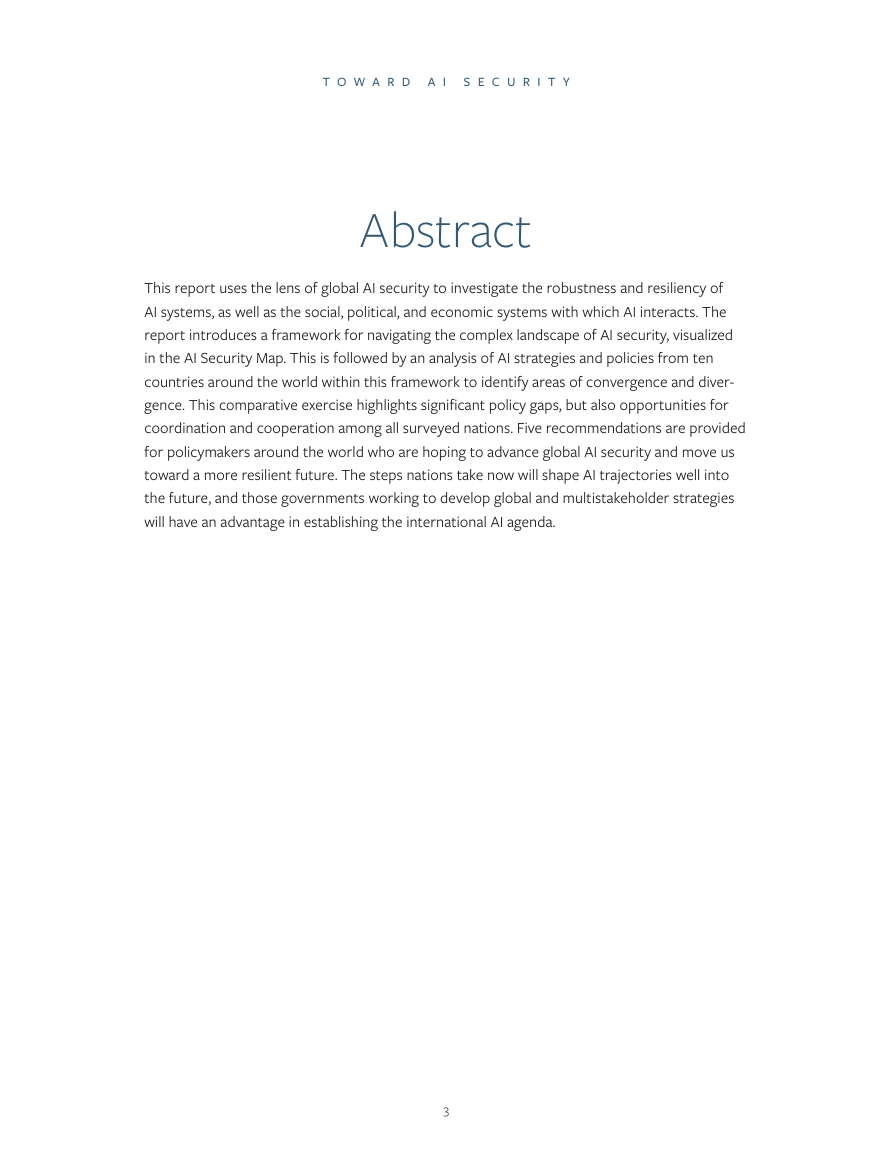C E N T E R F O R L O N G - T E R M C Y B E R S E C U R I T Y
C L T C W H I T E P A P E R S E R I E S
Toward AI Security
G L O B A L A S P I R A T I O N S F O R A M O R E R E S I L I E N T F U T U R E
J E S S I C A C U S S I N S N E W M A N
�
�
C L T C W H I T E P A P E R S E R I E S
Toward AI Security
G L O B A L A S P I R A T I O N S F O R A M O R E R E S I L I E N T F U T U R E
J E S S I C A C U S S I N S N E W M A N
FEBRUARY 2019
C E N T E R F O R L O N G - T E R M C Y B E R S E C U R I T Y
�
iviv
TOWARD AI SECURITY�
Contents
AI Security Map 13
1. Digital / Physical Domain 16
2. Political Domain 20
3. Economic Domain 25
4. Social Domain 29
Acknowledgements 2
Abstract 3
Recommendations 4
Introduction 6
AI 101 8
The Transformative Nature of AI 11
AI Security 13
Global AI Policy Responses 34
Global AI Security Priorities 68
Working with the Private Sector 70
Conclusion 72
Appendix I: AI Policy Compendium 73
Appendix II: Overview Of AI Policy Interests From Ten Countries 76
Endnotes 78
China 36
France 39
United Kingdom 45
United States 51
Canada 57
India 59
Japan 60
Singapore 62
South Korea 63
United Arab Emirates 65
1
TOWARD AI SECURITYTOWARD AI SECURITY�
Acknowledgements
The Center for Long-Term Cybersecurity (CLTC) would like to thank the following individuals
for their expertise, feedback, and contributions to this document: Anthony Aguirre, Seth Baum,
Niel Bowerman, Jared Brown, Ryan Calo, Betsy Cooper, Elsa Kania, Jade Leung, Nicolas Miailhe,
Deirdre Mulligan, Michael Page, Philip Reiner, Stuart Russell, and Helen Toner.
Special thanks to Steven Weber, Ann Cleaveland, and Chuck Kapelke of CLTC for their support,
feedback, and contributions to this report.
CLTC would also like to thank the Hewlett Foundation for making this work possible.
22
TOWARD AI SECURITY�
Abstract
This report uses the lens of global AI security to investigate the robustness and resiliency of
AI systems, as well as the social, political, and economic systems with which AI interacts. The
report introduces a framework for navigating the complex landscape of AI security, visualized
in the AI Security Map. This is followed by an analysis of AI strategies and policies from ten
countries around the world within this framework to identify areas of convergence and diver-
gence. This comparative exercise highlights significant policy gaps, but also opportunities for
coordination and cooperation among all surveyed nations. Five recommendations are provided
for policymakers around the world who are hoping to advance global AI security and move us
toward a more resilient future. The steps nations take now will shape AI trajectories well into
the future, and those governments working to develop global and multistakeholder strategies
will have an advantage in establishing the international AI agenda.
3
TOWARD AI SECURITYTOWARD AI SECURITY�
Recommendations
Based on the analysis of the gaps and opportunities in national AI strategies and policies, we
provide five recommendations for policymakers hoping to harness and direct AI technologies
for a more resilient and beneficial future. These recommendations outline concrete actions
that can be taken now to address a complex and quickly changing sociotechnical landscape:
1. Facilitate early global coordination where common interests can be identified. As
autonomous systems become more ubiquitous and capable, their reach and effects will be
more consequential and widespread. Global coordination and cooperation will be essen-
tial for ensuring sufficient oversight and control, but such cooperation will be harder to
achieve the longer we wait due to technological and institutional “lock-in”. The numerous
areas of convergence identified in this report can be leveraged as opportunities for collab-
oration and innovation, sharing best practices, and preventing global catastrophic risks.
2. Use government spending to shape and establish best practices. Governments have an
opportunity to establish standards and best practices while promoting AI development and
use, for example by implementing guidelines for government procurement of AI systems,
and by adding criteria such as safety, robustness, and ethics to AI R&D funding streams.
Additionally establishing processes to support transparent and accountable government
funding and use of AI technologies will help prevent misuse throughout public services and
protect government actors from the limitations and vulnerabilities of AI tools.
3.
Investigate what is being left on the table. The landscape of AI security is broad and
complex, as indicated in the AI Security Map presented in this report. The analysis of policy
documents identifies many gaps in different nations’ current AI policy approaches. Govern-
ments may choose to prioritize a sub-set of issues, but they should recognize the opportu-
nities and challenges they could be neglecting.
4. Hold the technology industry accountable. Many governments rightfully emphasize the
importance of partnership and engagement with industry and other AI stakeholders. How-
ever, while some firms are addressing AI challenges, significant gaps remain. Policymakers
have the unique primary responsibility to protect the public interest, and this responsibility
carries even greater weight during periods of significant technological transformation.
44
TOWARD AI SECURITY�
















 2023年江西萍乡中考道德与法治真题及答案.doc
2023年江西萍乡中考道德与法治真题及答案.doc 2012年重庆南川中考生物真题及答案.doc
2012年重庆南川中考生物真题及答案.doc 2013年江西师范大学地理学综合及文艺理论基础考研真题.doc
2013年江西师范大学地理学综合及文艺理论基础考研真题.doc 2020年四川甘孜小升初语文真题及答案I卷.doc
2020年四川甘孜小升初语文真题及答案I卷.doc 2020年注册岩土工程师专业基础考试真题及答案.doc
2020年注册岩土工程师专业基础考试真题及答案.doc 2023-2024学年福建省厦门市九年级上学期数学月考试题及答案.doc
2023-2024学年福建省厦门市九年级上学期数学月考试题及答案.doc 2021-2022学年辽宁省沈阳市大东区九年级上学期语文期末试题及答案.doc
2021-2022学年辽宁省沈阳市大东区九年级上学期语文期末试题及答案.doc 2022-2023学年北京东城区初三第一学期物理期末试卷及答案.doc
2022-2023学年北京东城区初三第一学期物理期末试卷及答案.doc 2018上半年江西教师资格初中地理学科知识与教学能力真题及答案.doc
2018上半年江西教师资格初中地理学科知识与教学能力真题及答案.doc 2012年河北国家公务员申论考试真题及答案-省级.doc
2012年河北国家公务员申论考试真题及答案-省级.doc 2020-2021学年江苏省扬州市江都区邵樊片九年级上学期数学第一次质量检测试题及答案.doc
2020-2021学年江苏省扬州市江都区邵樊片九年级上学期数学第一次质量检测试题及答案.doc 2022下半年黑龙江教师资格证中学综合素质真题及答案.doc
2022下半年黑龙江教师资格证中学综合素质真题及答案.doc